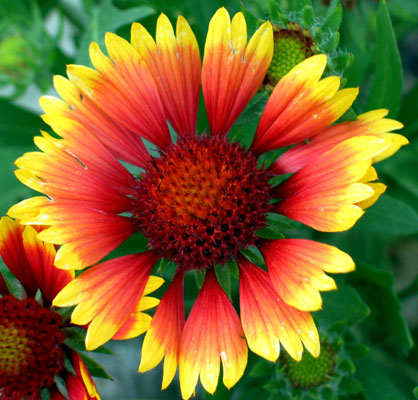Gymnosperms are seed bearing plants. They were developed in the carboniferous period around 350 millions years ago. Most are extinct but some there have been fossils of them.Their main body is the diploid sporophyte and is differentiated into root, stem, an leaves. Their name means "naked seed". Conifers are the largest gymnosperms. Gymnosperms are non flowering seed plants with seeds that are covered in an ovule.
Angiosperm
Divison Anthopyta or Angiosperm are vascular with seeds that are similar to gymnosperms but they are flowering plants. The flower are meant to protect the seeds from weather, animals, and humans. The seeds have two layers: inner layer that surrounds the seed and is used for storing food and protecting the seed from danger and a outer layer that protects the seeds from its environment and animals. They also produces seeds and their seeds are enclosed within fruits. Compared to Gymnosperms, Angiosperms have flowers and endosperm within their seeds. Angiosperms have roots, stems, leaves, and flowers. They are classfied into 8 groups: ; amborella, nymphaeales, austrobaileyales, chloranthales, magnoliidae, monocotyledonae, ceratophyllum and eudicotyledonae. Angiosperm have double fertilization.

Bryophytes
Embryophytes or Bryophytes. They are non vascular terrestrial green land plants that lacks the tissue for specialized woody water conducting vessels.Bryophytes are not a natural group as they do not produce flower or seeds.They lack tissue compare to other plants such as ligin or branched sporophytes. Their growth size are limited by their delicate non vascular structure. They first lived 420 million years ago. They make up the Bryophyta group which consists of mosses, liverworts, and hornworts. They can be dioicous or monoicous. Three lineages of Bryophytes are marchantiophyta, bryophyta and anthocerotophyta.

Pteridophytes
Pteridophytes are vascular plants because they possess xylem and phylum. Their xylem lacks companion cells. They are the first vascular land plants. The plant's main body is the sporophyte, which is differentiated into true roots, stems and leaves. The spores born in sporangia reprodcues the sporophytes. Sporangia are usually borne on fertile leaves called sporophylls. Pteridophytes are mostly homosporous, but some are heterosporous with microspores and megaspores. They are also classified as vascular cryptogams. They are separated into two groups: Lycopodiophyta and ferns. They can be dioicous or monoicous.

http://scitec.uwichill.edu.bb/bcs/bl14apl/pter1.htm
http://www.nhptv.org/natureworks/nwep14c.htm
http://biology.clc.uc.edu/courses/bio106/angio.htm
http://biology.clc.uc.edu/courses/bio106/gymnospr.htm
http://www.britannica.com/EBchecked/topic/250316/gymnosperm
No comments:
Post a Comment